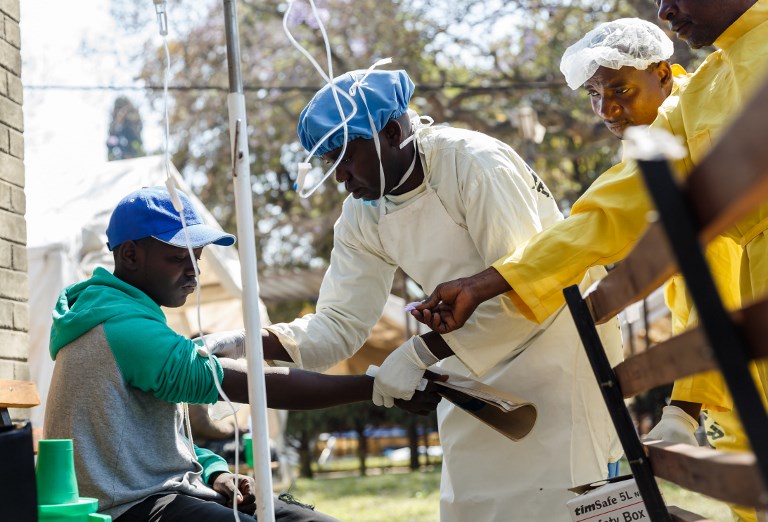
The place looks deserted as a few nurses attend to about five patients at the Glen View Poly Clinic, which was set up as one of the three cholera treatment centres in Harare at the height of the outbreak last year.
BY VANESSA GONYE
At the height of the outbreak, the clinic, which was declared one of the epicentres of the disease, was a hive of activity. Gogo Anna Mutomari (82) is sitting on a bench with an intravenous (IV) line (drip) on her left arm. She had been brought in earlier in the day complaining of incessant diarrhoea. As the team chats with her, watery stool starts flowing down her legs. She looks brave, but visibly in pain as she chats and laughs with the group.
“I drink water from the city council as I am a committed and loyal house owner in Glen Norah,” she says, oblivious of the fact that the council water she boasts of drinking could be the cause of her predicament.
Gogo Mutomari is one of the few people who still have trust in the City of Harare services and sees nothing wrong with drinking the water it supplies.
The water has several times been condemned as unsafe for drinking by various laboratory tests.
Across from her sits a woman who is hopelessly clutching her baby who she says had diarrhoea for the whole night.
These were the only serious cases of suspected cholera at the clinic last week. The government, with the aid of its partners including the World Health Organisation (WHO), corporates and concerned citizens, appears to have succeeded in containing the spread of the disease in Harare.
- Chamisa under fire over US$120K donation
- Mavhunga puts DeMbare into Chibuku quarterfinals
- Pension funds bet on Cabora Bassa oilfields
- Councils defy govt fire tender directive
Keep Reading
While the epidemic may seem to have been contained in Harare, there have been sporadic reports of the disease in outlying places and rural areas of the country. Two lives were lost in Mt Darwin and 26 other cases of suspected cholera were reported at the local hospital in November last year.
At the beginning of December, the disease resurfaced, this time in Murewa where a cholera outbreak was reported at a Johane Marange Apostolic sect shrine. Three members of the sect died. Several new cases have been reported, sometimes with fatalities and they all involve members of the apostolic faith sects who do not believe in taking their sick for medical treatment.
Only last week, the epidemic re-emerged in Murewa at another apostolic sect shrine and at least five people are believed to have succumbed to the disease.
In efforts to stop further outbreaks WHO rolled out a vaccination campaign in Harare in mid-October last year.
“The vaccination programme has worked hard to ensure the global cholera vaccine stockpile remains fully stocked and ready to help stop outbreaks such as this,” programme CEO Seth Barkley said when the vaccine was introduced.
At least 600 health workers in Zimbabwe were trained to carry out the vaccination campaign, with WHO supporting the government on a rollout strategy, which included making vaccinations available at health facilities, schools and shopping centres in selected areas.
Speaking at a media workshop on cholera and typhoid, in Mazowe in October, the director of Epidemiology and Disease Control in the Health and Child Care ministry, Dr Portia Manangazira, said the cholera epidemic had been contained.
Manangazira, who also spoke of the presence of typhoid in areas such as Mabvuku and Tafara from 2016 to date, said it had been difficult to completely outdo the disease.
“The emergence of typhoid in Midlands is proof that the disease cannot be completely eradicated. It can only be suppressed by antibiotics, including ciprofloxacin. It is resistant to drugs so with time therefore no total elimination can be achieved,” she said.
At least 1 000 cases of typhoid had been reported by August 15 in Gweru last year despite alleged attempts by the local authority to conceal the outbreak.
By mid-September about 2000 people had been treated for typhoid in Midlands, as the cholera outbreak that affected suburbs in Harare and parts of the country took prominence.
Women aged between 15-24 years were the most affected with 242 cases of typhoid recorded in contrast with males from the same age group who accounted for 160 cases by end of August.
In the wake of the cholera and typhoid scare, WHO then went on to introduce the Oral Cholera Vaccine (OCV), which was met with favourable responses in most areas where it was administered.
A WHO official who gave a presentation on the progress of vaccination of the two diseases said more than 700 000 doses of cholera vaccine had been administered while 320 000 doses of typhoid conjugate vaccine were to be rolled out in parts of Harare by end of November.
During a tour by journalists to assess the exercise’s progress at one OCV, more than 6 000 vaccines had been given out, while many more people waited for their turn.
They said they had responded to calls for vaccination against cholera which they had come across on various communication channels.
“We saw messages on our phones saying there was an OVC here and decided to come and get protected from cholera, you never know, it may attack us even if we do not live in a cholera zone,” said one woman who had accompanied her elderly mother for vaccination.
However, some people were said to have evaded vaccination owing to misconceptions surrounding the exercise.
“Some people who had taken the vaccine and appeared to have had side effects persuaded others not to take the vaccination. These numbers were however very little compared to those that volunteered for vaccination,” said Tanaka Gahadzikwa who was part of the health promotion team at Hopley where an OCV centre had been set up.











